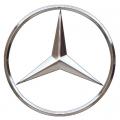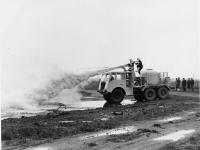Mercedes-Benz

June 28, 1926. The two oldest German automobile companies - the Daimler-Motoren-Gesellschaft from Stuttgart and Benz und Cie. from Mannheim were joined. As a result, the famous concern Daimler-Benz AG was formed, which produced well-known vehicles under the Mercedes Benz brand. Immediately after the joint, trucks were produced only on the Benz plant in Gaggenau, and the Daimler plants in Mannheim and Marienfelde temporarily were not used.
There was almost nothing left after the unification of the programs of both partners. The old Daimler DC/DR range was eliminated, and the only reminder of the Benz range was 5-ton L5 model. From the earliest days a typical indexing of the models was launched in the new company. Flatbed trucks got an index "L" with a digital indicator of it's payload in tonnes, dumpers - "K", all-wheel drive versions - "A", buses - "O", and later cabover models and truck tractors got the indices "P" and "S". Since 1929 the only figure in indices was replaced by a four-digit number.
After a passing sank into oblivion of a diesel engine, developments in this direction were continued by constructors of Daimler-Benz company Harts Nibel and Friedrich Nallinger. In 1927 according to their request Robert Bosch developed a new fuel injector and updated the process of the indirect mixing. Thus, all future Daimler-Benz diesel engines, which were working on low-grade fuel, had the "OM" index - shortening from Olmotor - oil engine.
The crisis of the late 20's forced the Daimler-Benz to cut producing volumes from 3800 to 1600 trucks per year. By the end of 1930 the situation become better after the introducing of cheap range Lo2000/2500 for urban distribution. Later Adolf Hitler came to power with a financial assistance of Daimler-Benz, who effectually granting a large government orders to the company. This led to fast growing of Daimler-Benz company, and it became in the biggest engineering concern in Germany. By 1937 the concern Daimler-Benz made about 10 thousand trucks.
Since the mid 30-ies the Daimler-Benz began developments of military equipment. In 1938, the issue of army vehicles exceeded the production of civilian trucks, and since 1940, almost all production was transferred to the production of military products. During the war, Daimler-Benz was producing military versions of its civilian vehicles, and since 1942 in Mannheim began to assemble a 3-ton "L701" truck - the analog of the Opel Blitz truck. Daimler Benz also produced semi-tracked armored personnel carriers and trucks, tanks of all series, including heavy tank Panther, self-propelled artillery and aircraft engines.
At the end of the war, all the plants of Daimler-Benz concern were seriously damaged after bombing and ground fighting. The plants in Sindelfingen, Untertürkheim and Gaggenau had been destroyed by 70-85%. The plant in Mannheim, had been destroyed only on 20%, but the plants near Berlin were razed to the ground. However, the disastrous results have been reduced since shortly before the end of the war the most important and expensive equipment was hidden in secret vaults - in mine shafts, caves, tunnels and railways. In the early postwar period in the surviving workshops began repairing of cars for the occupation authorities.
1954 was the starting point in creating of a future wide L range. And in the early 60's the range of Mercedes-Benz trucks consisted of thirty 2 - and 3-axle models with payload from 1,75 to 15 tons with 45-200 hp engines, included seven basic families and recognized one of the most perfective in the world. Mercedes-Benz trucks were exported to almost 100 countries. Assembly branches were opened in Spain, Brazil, Argentina and Australia, the licensed production was started in India by the Tata company.
Another turn in history of Daimler-Benz took place in 1963, when unified families of different classes were introduced, which had a modular method and a single corporate design. The main feature of the new families was using diesel engines with direct fuel injection. These changes followed by a change in indexation of models, which is using and now: the first one or two digits indicate the rounded GVW in tonnes, other figures after the point indicate the engine power to tens of horsepower.
In 80-ies the Daimler-Benz concern continued its policy of buying companies and expanding spheres of influence. Starting with an agreement about cooperation with Swiss company FBW at the end of 1982, the Daimler-Benz acquired not only this company, but also one of the oldest manufactures of trucks - the Saurer company, and turned them into the NAW branch to produce heavy-duty vehicles. The most successful step was in 1980. The Daimler Benz joined the U.S. company Freightliner. In 80-ies Mercedes-Benz trucks and engines were producing in Yugoslavia, Turkey, Greece, Indonesia, Argentina, Mexico, Saudi Arabia and Nigeria. Since 1981 an assembly plant began to work in Cairo, in 1986 a license was sold to China and several small companies began to assemble truck according to it.
In the late 80's the Daimler-Benz concern has been renamed to Mercedes-Benz. At present time the concern is owner of 14 factories in Germany and 25 companies abroad. Annual production volume is over 420 thousand vehicles. May 7, 1998 the Daimler-Benz has joint with the US Chrysler Corporation and created a new multinational concern Daimler Chrysler. In 1999, the concern has produced 287.4 thousand vehicles with GVW over 6 t (19,0% of world production). In 2000, the Daimler Chrysler bought the part of shares of Japanese company Mitsubishi and South Korean Huyndai, and in the United States became the owner of the Sterling and American LaFrance companies, in Canada - the Western Star company. In mid-2000 over474.8 thousand people work in Daimler Chrysler, while total revenue was 41.7 million dollars.


